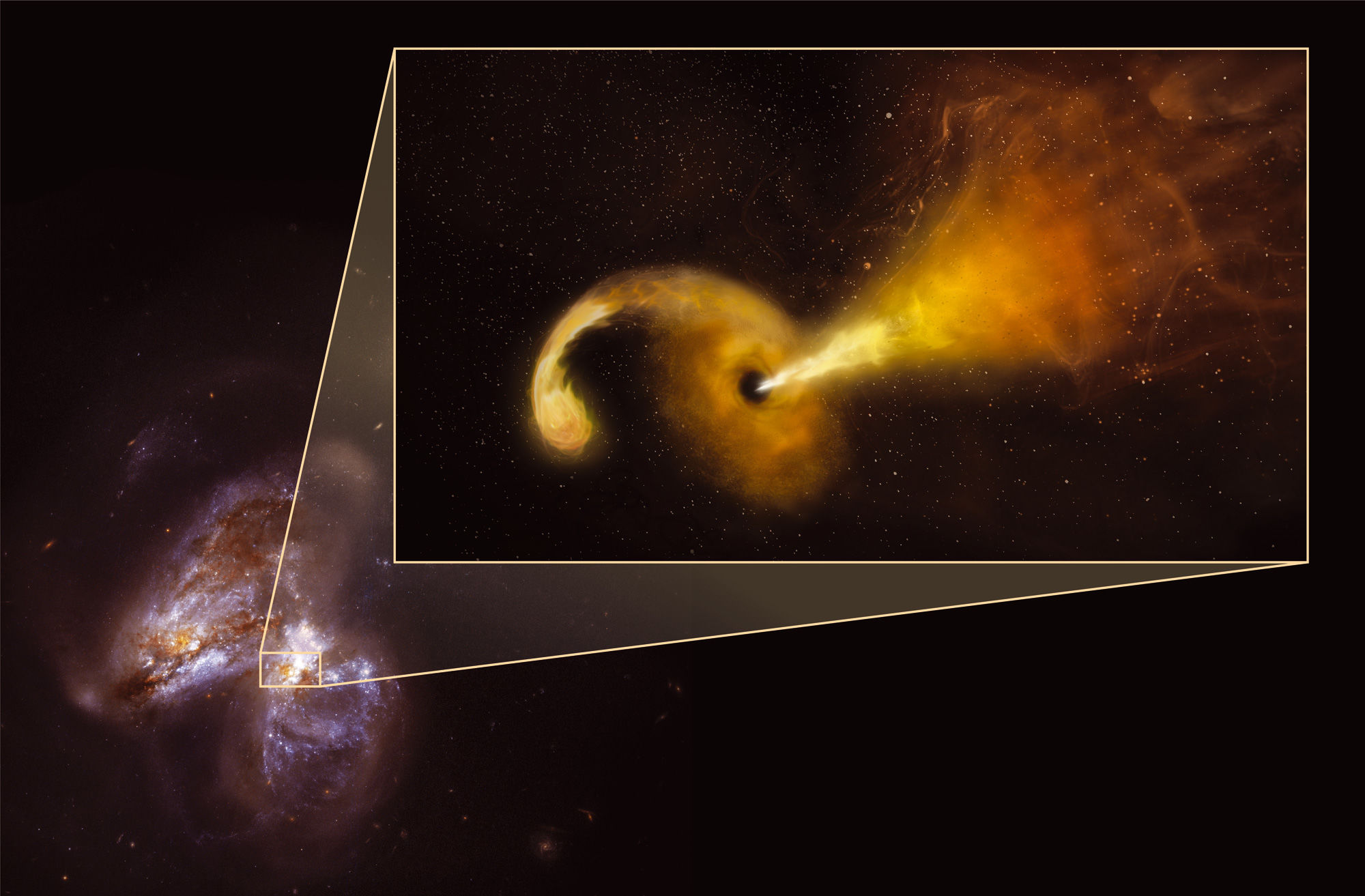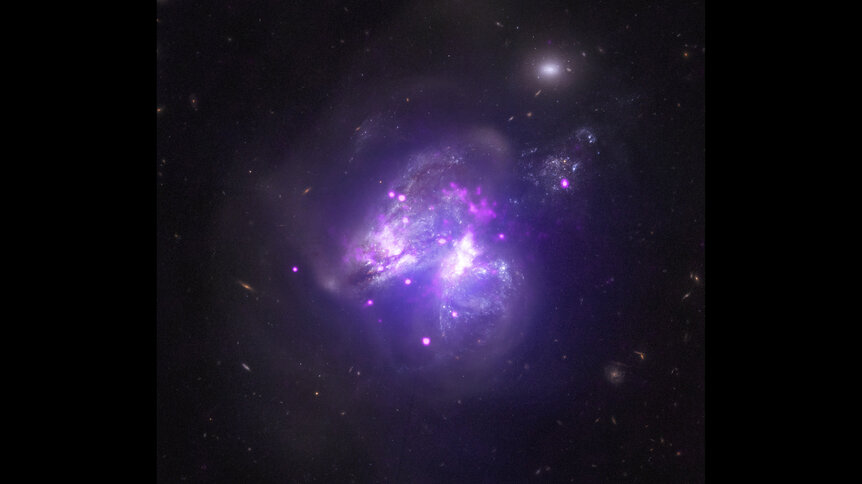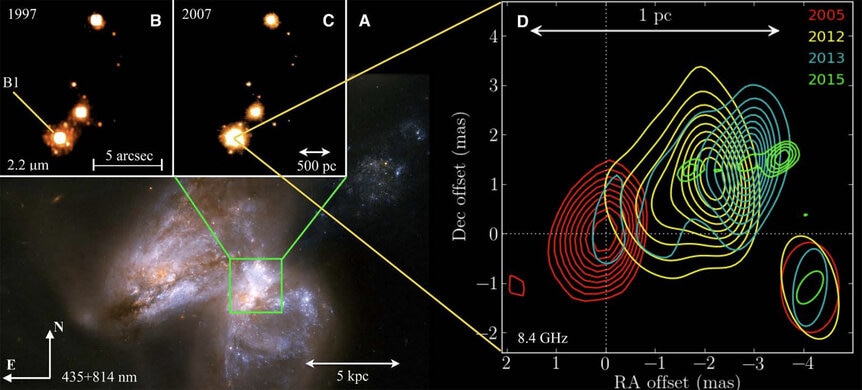Create a free profile to get unlimited access to exclusive videos, sweepstakes, and more!
Astronomers watch the aftermath of a star ripped apart by a huge black hole

For the first time, astronomers have seen the expanding debris blasted away from a monster black hole after it literally tore a star apart and ate half of it.
So, yeah. That was an amazing sentence to be able to write.
Here's the deal. In the center of every big galaxy is a big black hole, one so big we call it supermassive. When the Universe was young this central black hole formed along with its galaxy, and in many ways the two affect each other as they both grow. Over time, as the galaxy grows big, so does that beast in the middle.
The Milky Way, our home galaxy, has one that weighs in at around 4 million times the mass of the Sun — literally, it's as if four million stars like the Sun were squeezed into a volume that could easily fit between the actual Sun and Mercury's orbit.
The gravity of such a thing is immense. From far away it just feels like the combined pull of four million stars, which is a lot, but not that much more than, say, that of a big cluster of stars.
The danger is when you get close. The force of gravity increases steeply as you approach one, and this can be disastrous*: For a big object on approach to the Point Of No Return, the force it feels on the side facing the black hole can be far larger than the side facing away. This feels like a force stretching the object, pulling it apart. We call this the tidal force, and near a black hole it can be so large it can quite literally tear the object apart.
Which brings us to Arp 299.
This odd–looking object is actually two objects, two huge galaxies that are physically colliding and merging (the more oval one above and to the left is IC 694, and the rounder one to the lower right is NGC 3690). This cosmic train wreck has been playing out for some tens of millions of years, wreaking havoc on a vast scale. Each galaxy has been distorted and shaken by the gravity of the other, affecting them across their entire lengths. This includes slamming gas clouds into one another, which triggers star formation at a furious rate. It also dumps lots of gas and dust into the centers of the galaxies.
Mind you, both of these galaxies have a supermassive black hole in its core. The black hole in NGC 3690 has a mass of about 20 million times the Sun's, and is enshrouded in an incredibly thick torus of gas and dust, blocking our view of it directly. We know this for many reasons, but a big one is that it glows fiercely in infrared and radio light, while giving off almost none in optical wavelengths. Dust does exactly that; it blocks the kind of light we see, but can allow longer wavelengths to get through.
That fact is at the heart (so to speak) of this story. In 2005, astronomers spotted something interesting going on in the core of NGC 3690. They were examining galaxies with lots of star formation, looking for heavily obscured supernovae. The thinking was that if lots of stars are being born, then some are very massive, don't live long, and explode. If this happens in the middle of a dust cloud the supernova won't appear very bright in optical light, but will blast out infrared and radio.
That's what they thought they had in the center of NGC 3690. But over time it became clear that something more extraordinary was going on. After a few years, the source of the radio waves could be seen to be moving quite rapidly.
And I mean rapidly: It was initially screaming across space away from the galactic center at 99.5% of the speed of light! That's nearly 300,000 kilometers per second. It slowed after a month or so to about one-fourth light speed, but that's still ridiculously fast. No supernova could do that, and not for such a long time. There's another type of eruption called a gamma-ray burst, which is even more energetic and terrifying than a supernova, but the data weren't consistent with that either. Something else must be going on.
The only other option was an event only a black hole could trigger: The tidal disruption of a star. Meaning, it tore an entire star literally to shreds.
From the energy involved, it looks like a star about 2 – 6 times as massive as the Sun wandered too close to the black hole in the center of NGC 3690. The enormous tides from the hole pulled on the star so colossally that it stretched beyond its limits, and was ripped apart.
Perhaps we should take a moment to let that settle into your brain. A star is an immense object, several octillion tons of superheated gas held together by its own very significant gravity. And yet this black hole casually tore it in half like a cat shredding a roll of toilet paper.
About half the mass of the star fell toward the black hole, swirling around it before plunging down, creating a huge amount of energy. The other half was ejected from the black hole, shaped by the infernal forces there into a narrow beam of material, blasting away like a death ray. It was this jet that the astronomers saw moving across the galaxy at high speed, tracking it for more than a decade as its material physically moved in their observations.
The kinetic energy, the energy of motion, of this material is brain-melting: It was 2 x 1051 ergs… roughly the same amount of energy the Sun will emit over its entire lifetime.
And that's just the kinetic energy. The total energy emitted as this massive star was torn apart was 100 times that amount. One hundred times. And about a tenth of that was emitted just as radio and infrared light.
I am, uncharacteristically, at a loss for words. Energy on this scale is crushingly destructive, and jams my brain.
Astronomers, as is their wont, gave this sort of thing a typically prosaic handle: a tidal disruption event, or TDE. We've seen them before, several times, but never before has the motion of the ejected material been directly tracked. It's a fantastic observation. By seeing the motion of the gas, they've been able to nail down how much energy the event emitted, and how that material was shaped. This helps us understand the physics a great deal.
It's a lucky discovery, too. TDEs are likely to happen far more often in merging galaxies than relatively isolated ones like the Milky Way, since the event can disturb the orbits of stars and drop them too close to the central supermassive black holes. But it doesn't happen for long; after about 300,000 years or so things settle down, the merger cleans up, and you're left with a distorted but mostly quiet galaxy once again. As the two galaxies making up Arp 299 finish their dance, TDEs will become less common.
… but now might be a good time to remind you that the Milky Way isn't as isolated as all that. The Andromeda Galaxy is 2.5 million light-years away, and heading toward us. As it closes in, what happened in Arp 299 will happen to us. The two galaxies will distort, gas clouds will collide, stars will form furiously, and perhaps a star or hundred will find itself skimming too close to our own black hole. Tidal disruption events will occur here, too, as our two galaxies merge into one.
The good news: That won't be for another, oh, say, four billion years or so.
As an astronomer, I'll admit it would be cool to get a better look at one of these TDEs. But you know what? I can wait.
* Literally, since "disaster" means "bad star."
















